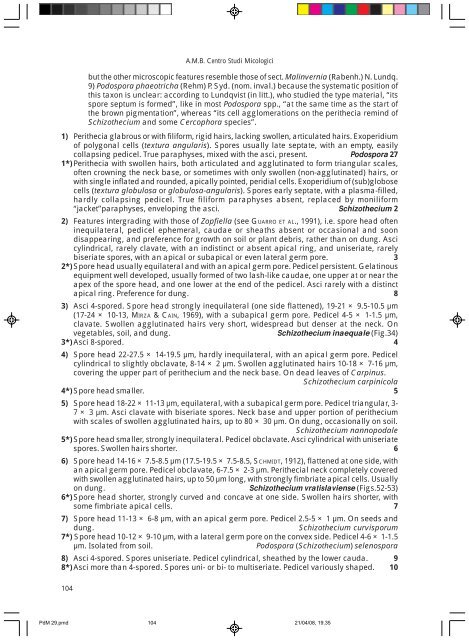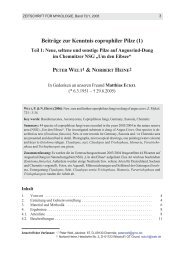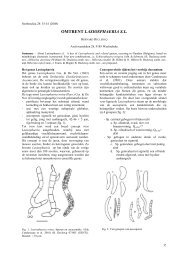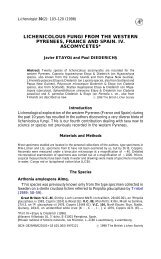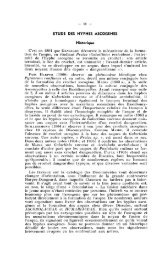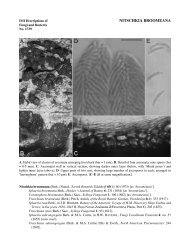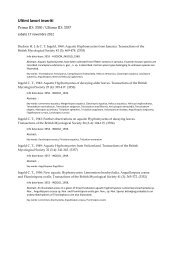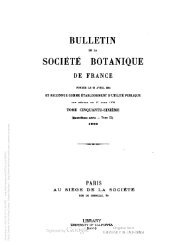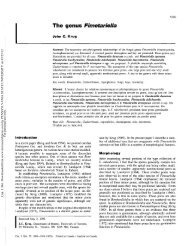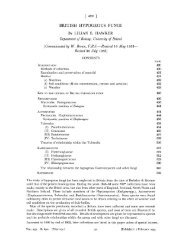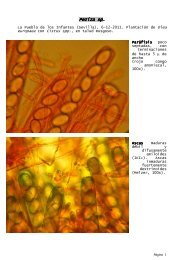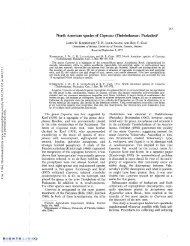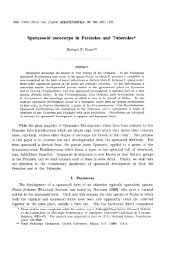A bibliography of Podospora and Schizothecium, a key to the ...
A bibliography of Podospora and Schizothecium, a key to the ...
A bibliography of Podospora and Schizothecium, a key to the ...
You also want an ePaper? Increase the reach of your titles
YUMPU automatically turns print PDFs into web optimized ePapers that Google loves.
104<br />
A.M.B. Centro Studi Micologici<br />
but <strong>the</strong> o<strong>the</strong>r microscopic features resemble those <strong>of</strong> sect. Malinvernia (Rabenh.) N. Lundq.<br />
9) <strong>Podospora</strong> phaeotricha (Rehm) P. Syd. (nom. inval.) because <strong>the</strong> systematic position <strong>of</strong><br />
this taxon is unclear: according <strong>to</strong> Lundqvist (in litt.), who studied <strong>the</strong> type material, “its<br />
spore septum is formed”, like in most <strong>Podospora</strong> spp., “at <strong>the</strong> same time as <strong>the</strong> start <strong>of</strong><br />
<strong>the</strong> brown pigmentation”, whereas “its cell agglomerations on <strong>the</strong> peri<strong>the</strong>cia remind <strong>of</strong><br />
<strong>Schizo<strong>the</strong>cium</strong> <strong>and</strong> some Cercophora species”.<br />
1) Peri<strong>the</strong>cia glabrous or with filiform, rigid hairs, lacking swollen, articulated hairs. Exoperidium<br />
<strong>of</strong> polygonal cells (textura angularis). Spores usually late septate, with an empty, easily<br />
collapsing pedicel. True paraphyses, mixed with <strong>the</strong> asci, present. <strong>Podospora</strong> 27<br />
1*) Peri<strong>the</strong>cia with swollen hairs, both articulated <strong>and</strong> agglutinated <strong>to</strong> form triangular scales,<br />
<strong>of</strong>ten crowning <strong>the</strong> neck base, or sometimes with only swollen (non-agglutinated) hairs, or<br />
with single inflated <strong>and</strong> rounded, apically pointed, peridial cells. Exoperidium <strong>of</strong> (sub)globose<br />
cells (textura globulosa or globulosa-angularis). Spores early septate, with a plasma-filled,<br />
hardly collapsing pedicel. True filiform paraphyses absent, replaced by moniliform<br />
“jacket”paraphyses, enveloping <strong>the</strong> asci. <strong>Schizo<strong>the</strong>cium</strong> 2<br />
2) Features intergrading with those <strong>of</strong> Zopfiella (see GUARRO ET AL., 1991), i.e. spore head <strong>of</strong>ten<br />
inequilateral, pedicel ephemeral, caudae or sheaths absent or occasional <strong>and</strong> soon<br />
disappearing, <strong>and</strong> preference for growth on soil or plant debris, ra<strong>the</strong>r than on dung. Asci<br />
cylindrical, rarely clavate, with an indistinct or absent apical ring, <strong>and</strong> uniseriate, rarely<br />
biseriate spores, with an apical or subapical or even lateral germ pore. 3<br />
2*) Spore head usually equilateral <strong>and</strong> with an apical germ pore. Pedicel persistent. Gelatinous<br />
equipment well developed, usually formed <strong>of</strong> two lash-like caudae, one upper at or near <strong>the</strong><br />
apex <strong>of</strong> <strong>the</strong> spore head, <strong>and</strong> one lower at <strong>the</strong> end <strong>of</strong> <strong>the</strong> pedicel. Asci rarely with a distinct<br />
apical ring. Preference for dung. 8<br />
3) Asci 4-spored. Spore head strongly inequilateral (one side flattened), 19-21 × 9.5-10.5 µm<br />
(17-24 × 10-13, MIRZA & CAIN, 1969), with a subapical germ pore. Pedicel 4-5 × 1-1.5 µm,<br />
clavate. Swollen agglutinated hairs very short, widespread but denser at <strong>the</strong> neck. On<br />
vegetables, soil, <strong>and</strong> dung. <strong>Schizo<strong>the</strong>cium</strong> inaequale (Fig.34)<br />
3*) Asci 8-spored. 4<br />
4) Spore head 22-27.5 × 14-19.5 µm, hardly inequilateral, with an apical germ pore. Pedicel<br />
cylindrical <strong>to</strong> slightly obclavate, 8-14 × 2 µm. Swollen agglutinated hairs 10-18 × 7-16 µm,<br />
covering <strong>the</strong> upper part <strong>of</strong> peri<strong>the</strong>cium <strong>and</strong> <strong>the</strong> neck base. On dead leaves <strong>of</strong> Carpinus.<br />
<strong>Schizo<strong>the</strong>cium</strong> carpinicola<br />
4*) Spore head smaller. 5<br />
5) Spore head 18-22 × 11-13 µm, equilateral, with a subapical germ pore. Pedicel triangular, 3-<br />
7 × 3 µm. Asci clavate with biseriate spores. Neck base <strong>and</strong> upper portion <strong>of</strong> peri<strong>the</strong>cium<br />
with scales <strong>of</strong> swollen agglutinated hairs, up <strong>to</strong> 80 × 30 µm. On dung, occasionally on soil.<br />
<strong>Schizo<strong>the</strong>cium</strong> nannopodale<br />
5*) Spore head smaller, strongly inequilateral. Pedicel obclavate. Asci cylindrical with uniseriate<br />
spores. Swollen hairs shorter. 6<br />
6) Spore head 14-16 × 7.5-8.5 µm (17.5-19.5 × 7.5-8.5, SCHMIDT, 1912), flattened at one side, with<br />
an apical germ pore. Pedicel obclavate, 6-7.5 × 2-3 µm. Peri<strong>the</strong>cial neck completely covered<br />
with swollen agglutinated hairs, up <strong>to</strong> 50 µm long, with strongly fimbriate apical cells. Usually<br />
on dung. <strong>Schizo<strong>the</strong>cium</strong> vratislaviense (Figs.52-53)<br />
6*) Spore head shorter, strongly curved <strong>and</strong> concave at one side. Swollen hairs shorter, with<br />
some fimbriate apical cells. 7<br />
7) Spore head 11-13 × 6-8 µm, with an apical germ pore. Pedicel 2.5-5 × 1 µm. On seeds <strong>and</strong><br />
dung. <strong>Schizo<strong>the</strong>cium</strong> curvisporum<br />
7*) Spore head 10-12 × 9-10 µm, with a lateral germ pore on <strong>the</strong> convex side. Pedicel 4-6 × 1-1.5<br />
µm. Isolated from soil. <strong>Podospora</strong> (<strong>Schizo<strong>the</strong>cium</strong>) selenospora<br />
8) Asci 4-spored. Spores uniseriate. Pedicel cylindrical, shea<strong>the</strong>d by <strong>the</strong> lower cauda. 9<br />
8*) Asci more than 4-spored. Spores uni- or bi- <strong>to</strong> multiseriate. Pedicel variously shaped. 10<br />
PdM 29.pmd 104<br />
21/04/08, 19.35


